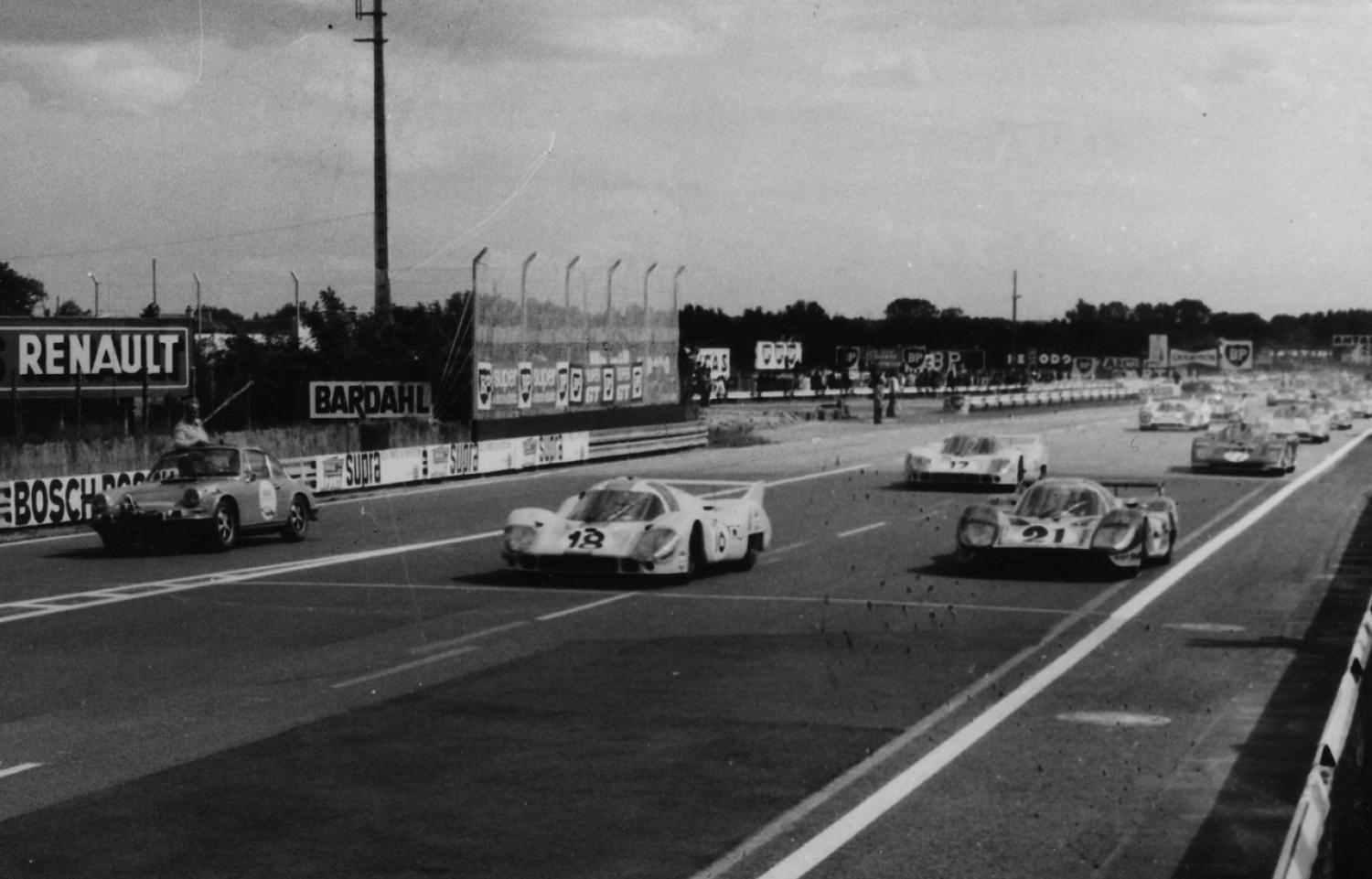Fifty years ago, a new start procedure was introduced at the 24 Hours of Le Mans, which remains in effect to this day. But that wasn't the only exciting aspect of the 39th running of the race. Here are a few standouts.
On Saturday 14 June 1969, Jacky Ickx walked across the track during the start of the race and took off dead last before snatching the win in the final lap the next day. That move sounded the death knell for the traditional start of the 24 Hours. In 1970, the cars lined up in the same formation, but with the drivers already strapped in rather than having to run to their cars. This start was immortalized in the film Le Mans produced by and starring Steve McQueen. On 12 June 1971, the running start was forever replaced by the current procedure in which a safety car releases the cars on the track.
Helmut Marko and Gijs van Lennep, two winners set a new record – After qualifying fifth and experiencing only one setback early in the race in the form of an alternator belt change, Austrian driver Helmut Marko and Dutchman Gijs van Lennep snatched the lead in the 13th hour. With 397 laps completed and 5,335 km traveled (at an average 222 kph), they established a new distance record that would remain unbeaten until 2010. The first citizen of his country to win Le Mans, van Lennep triumphed again in 1976 before retiring. Sadly, Marko's career came to an abrupt end at the 1972 F1 French Grand Prix when a stone kicked up by Emerson Fittipaldi's Lotus robbed him of the use of one eye. Now age 78, he manages the network of young Red Bull drivers, three of which have won the 24 Hours in recent years: Neel Jani (2016), Brendon Hartley (2017, 2020) and Sébastien Buemi (2018, 2019, 2020).
The Porsche 917 show – Porsche's second win at the race was also the second for the 917 that set three records in 1971. In addition to the one for distance set by Martini Racing, the 917 LH fielded by Gulf surpassed the 250 kph lap average thanks to Jackie Oliver during a preliminary free practice in April (3:13.6) then pole-sitter Pedro Rodríguez during qualifying (3:13.9). Martini Racing's #23 917 also became iconic with its dotted pink livery representing the various parts of a pig as a nod to the region famous for pork rillettes. At the 2018 24 Hours and in celebration of its 70th anniversary, Porsche resurrected the design for its #92 factory 911 RSR. Kévin Estre, Michael Christensen and Laurens Vanthoor won the LMGTE Pro class that year.
Luigi Chinetti, the 24 Hours of Le Mans from father to son – To face off against the Porsche 917, 10 Ferrari 512 Ms were fielded by partner and client outfits, but no factory team. Luigi Chinetti's NART claimed the third step on the podium thanks to American duo Sam Posey/Tony Adamowicz. The NART team also finished fifth with a GT, the #58 365 GTB/4 driven by Luigi Chinetti, Jr. who ended his rookie 24 Hours in the top 5 along with Bob Grossman, a veteran of the American outfit.
Marie-Claude Beaumont, the "first lady" of the 1971 24 Hours – That year marked the first participation for Marie-Claude Charmasson, a.k.a. Marie-Claude Beaumont, driving a Chevrolet Corvette fielded by her teammate Henri Greder. Forced to retire at the running of the race, the duo stayed together until 1974 with as best result a 12th place finish in 1973. Beaumont then formed an all-female crew with Italian driver Lella Lombardi at the wheel of a Renault-Alpine prototype in 1975, and took the start in her final 24 Hours in 1976, finishing 19th with a Porsche 934 along with Didier Pironi and Bob Wollek.
Matra and Ligier, French ambitions – Three years after Henri Pescarolo's nighttime misfortune running out of windshield wiper fluid and being forced to retire as he was in second place, the only Matra entered in 1971 held the position at dawn. After three hours, Chris Amon and Jean-Pierre Beltoise retired with fuel injection troubles. But Matra was already looking to the future, succeeding the Porsche 917 and entering the 24 Hours hall of fame with three consecutive wins from 1972 to 1974. Also in 1971, Guy Ligier entered the first racing car bearing his name, the JS3 prototype he shared with Patrick Depailler. They reached fifth position during the 18th hour before incurring a gearbox bearing problem. The Ligier spent three hours in its garage for repairs, the time it took to adapt a replacement part from the Gulf team. This lovely gesture of solidarity allowed the car to return to the track cheered on by spectators and cross the finish line. But the car did not make the classification as it had failed to complete the minimum required distance by 21 laps. Still competing today, under the leadership of Jacques Nicolet, Ligier is a major player in the LMP2 and LMP3 classes.
PHOTOS (Copyright - ACO Archives): LE MANS (SARTHE, FRANCE), 1971 24 HOURS OF LE MANS. From top to bottom: the first rolling start in the history of the 24 Hours of Le Mans, with in pole position the Porsche 917 LH of Pedro Rodríguez/Jackie Oliver (#18) and at right the Porsche 911 that led the formation lap; the Porsche 917s of winners Helmut Marko/Gijs van Lennep (#22) and Reinhold Joest/Willi Kauhsen (#23) called Pink Pig; the Ferrari 365 GTB/4 of Luigi Chinetti, Jr./Bob Grossman (#58); the Chevrolet Corvette of Marie-Claude Beaumont/Henri Greder (#2).





